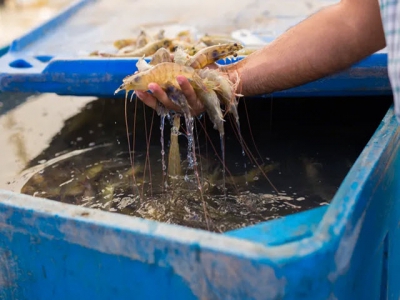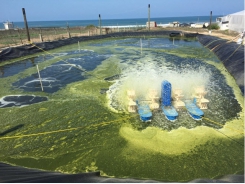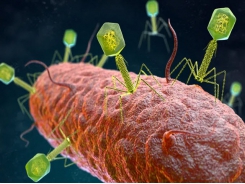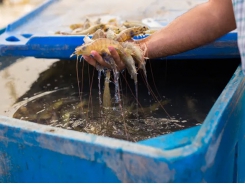Biomass - the billion-dollar shrimp question - Part 2

Nursery
When using a nursery phase pond, the transfer to grow-out is an opportunity to accurately estimate biomass in a way unachievable in grow-out ponds. The method suggested here is one of a few options, but is a stressful event for the shrimp. However, the benefits of accurate biomass and better feed conversions outweigh the risks when managed properly.
During transfer, ensure all water bodies have active oxygenation and measure at dissolved oxygen (DO) of 5 or higher, ideally above 6. Using a container, bucket or net, transfer shrimp between water bodies. Record the weight of each container of shrimp should and occasionally count the individuals in one container (along with its weight). Use these data points to calculate the total shrimp biomass. Observe the shrimps’ behaviour after transfer and estimate a percentage of mortality due to stress.
Grow-out
Identifying and estimating early mortality is important during the blind feeding phase, when disease and stress could cause significant losses without obvious signs. Whilst mortality may be hard to observe, counting dead shrimp, as well as siphoning and observing water samples for excess feeding, are tools that may be used to support assumptions. In later days of culture (DOC) cast nets and feed trays can be used to assume survival rates and pond population, although the accuracy of these methods is limited.
Measuring biomass is easier to achieve by weighing the wet or dry weight of multiple samples of shrimp from the pond. Ideally, the shrimp should be sampled from multiple areas in the same pond. This can be considered an accurate, low cost method to measure average body weight of shrimp, however it is labour intensive and stressful for the shrimp.
Partial harvests and final harvests are chances to evaluate the accuracy of your predictions and analysis during the cycle.
How emerging technologies can deliver more accurate biomass data?
Researchers have been trialling ways to accurately estimate biomass, hoping to find a method that’s non-intrusive and cost effective. Identifying the most representative sampling method and making estimation technologies more efficient have been the two main strategies. As it stands now, no technology has been able to address these needs, but there have been great steps forward and as shrimp farms modernise and higher cost solutions become viable.
Machine vision
Machine vision is a technology that uses a combination of big data, machine learning and cameras or sensors to acquire, process and analyse underwater snapshots of shrimp. This method has been used for rainbow trout, salmon, bluefin tuna and shrimp. Canadian aquaculture company XpertSea have developed a machine vision artificial intelligence system to measure the number, size and weight of a shrimp sample using their XpertCount bucket. XpertSea have recently launched a mobile version of their technology, which allows size and variation estimates through a mobile phone, reducing barriers for adoption of this useful solution.
*Algaeba, like XpertSea, uses machine vision for PL counting, with much faster speed and better accuracy than the meticulous hand counting method employed by many farmers. The Thai aquaculture technology company promises a 1-minute preparation and counting time with >95 percent accuracy.

(Figure 1) Machine vision system for fish biomass estimation. Photo: Li, et.al. 2019
Acoustics
Other ways of acquiring biomass data include using an acoustic-based method. Instead of using optics and cameras this method uses sound to capture data, using sonar cameras or echosounders. *Minnowtech, a US-based aquaculture technology company, is combining networked underwater sonar cameras and artificial intelligence to acquire biomass data directly in the ponds, at a level which represents both individual shrimp size and total pond biomass. While the technology is not yet available for farmers, it is an exciting development and innovation that promises to help shift shrimp farming towards a precision industry.

(Figure 2) (a) A fish is in the field of view of an imaging sonar technique. (b) The imaging results are shown: a is the horizontal view angle and b is the vertical view angle of the imaging sonar technique. Photo: Li, et.al. 2019
Historically the adoption of technology in shrimp farming has been slow – limited by cost and access to capital. In some cases, new technologies haven’t been embraced because farmers don’t know how to use the equipment correctly or because the benefits of the technology aren’t obvious. Manual methods have a proven track record, while new technologies require support and an integrated approach to complement how the farm team prefers to work. It is important for farmers to test and embrace innovations, while technology companies should seek to reduce barriers to adoption.
The future of biomass estimation
As the race for a farmer-friendly biomass solution continues, producers can work to improve traditional estimation methods. Accurately recording farm data, taking frequent samples, using representative sample sizes and maintaining the same procedures throughout production will make farmers more confident about the changes they observe in shrimp ponds.
Technology to simplify and assist traditional estimation methods is already here and is becoming more widely available to farmers. It is unlikely one solution will answer the question of biomass estimation, but if farmers work with technology companies, they can start seeing the bottom of the pond more clearly.
Related news
Tools

Phối trộn thức ăn chăn nuôi

Pha dung dịch thủy canh

Định mức cho tôm ăn

Phối trộn phân bón NPK

Xác định tỷ lệ tôm sống

Chuyển đổi đơn vị phân bón

Xác định công suất sục khí

Chuyển đổi đơn vị tôm

Tính diện tích nhà kính

Tính thể tích ao




 Krill oil shown to enhance growth and survival…
Krill oil shown to enhance growth and survival…  Biomass - the billion-dollar shrimp question - Part…
Biomass - the billion-dollar shrimp question - Part…